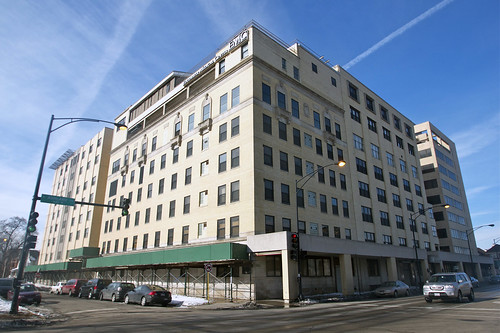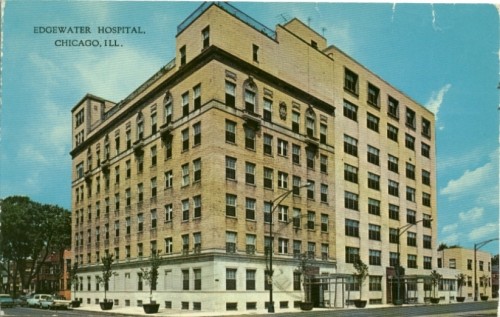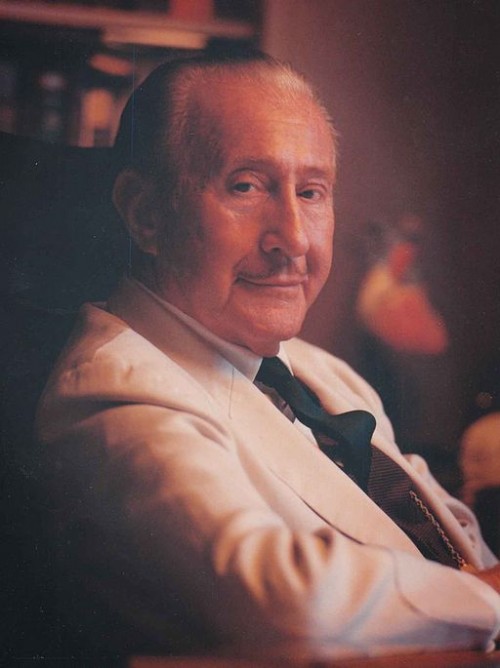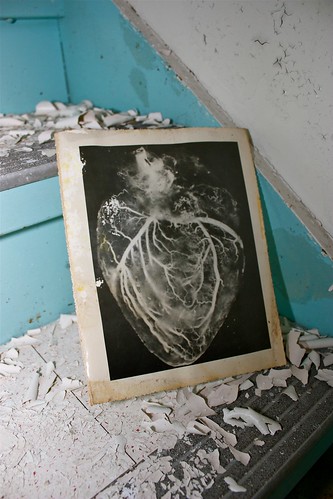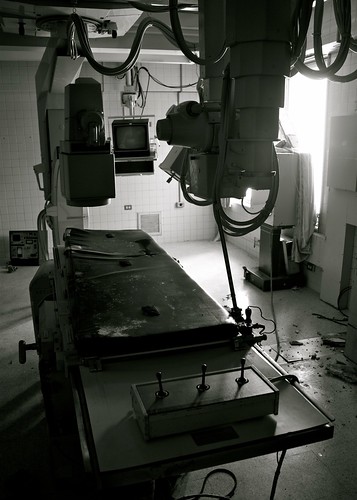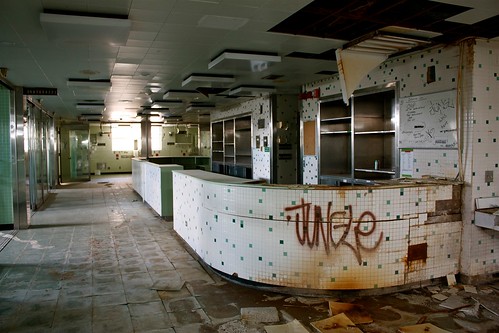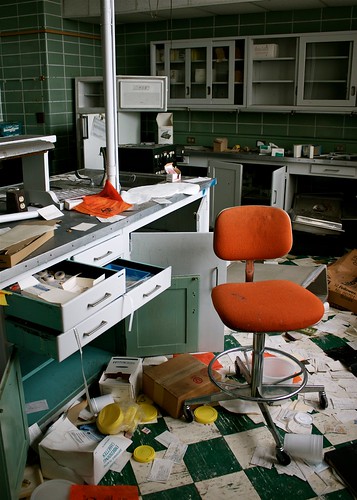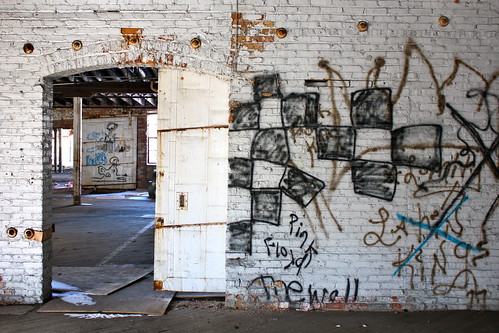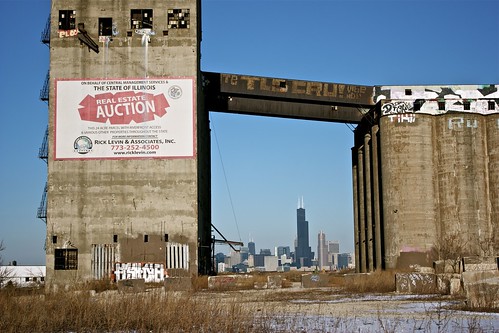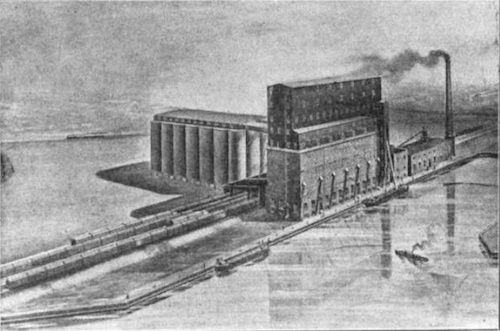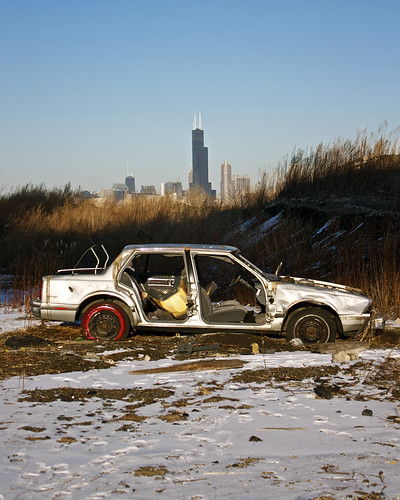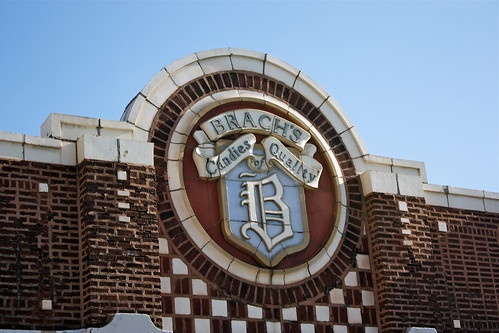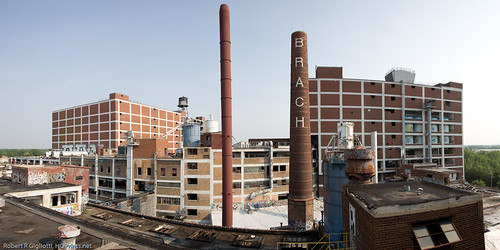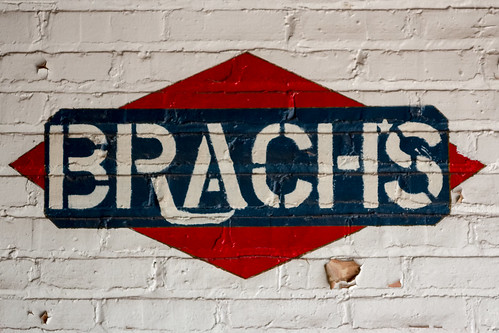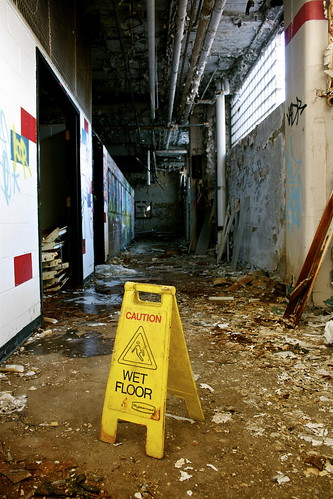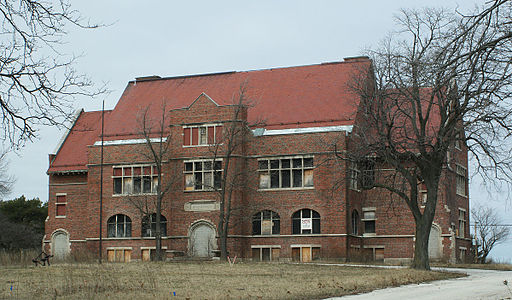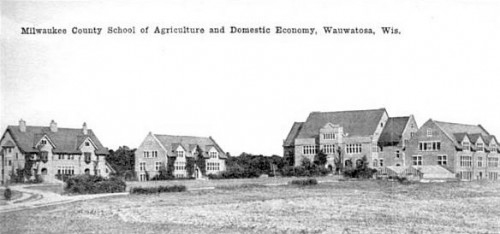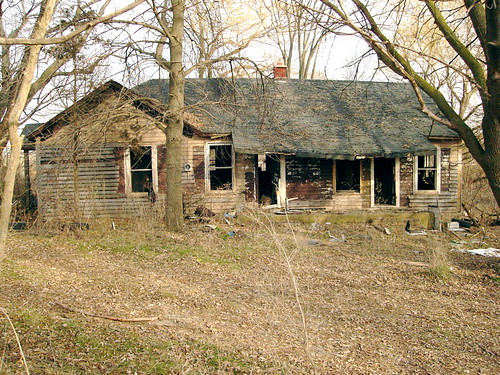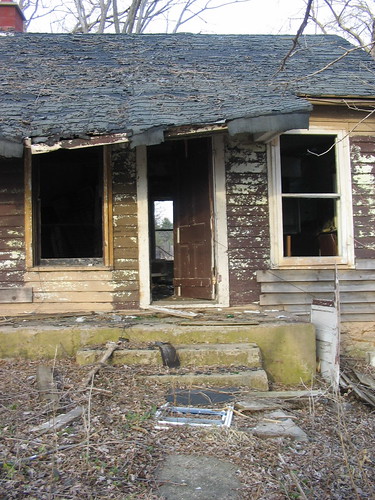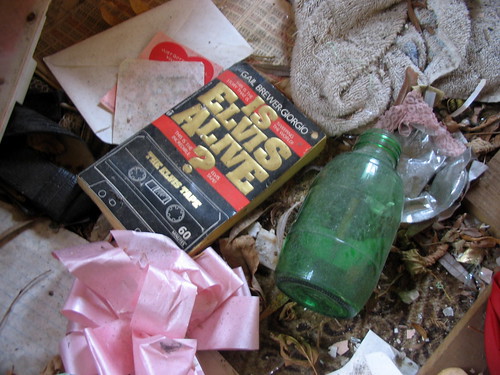American Urbex recently did some German to English translation work for Urbexers Against Vandalism. American Urbex supports their efforts to differentiate the benevolent actions of urban explorers from the destructive acts of vandals. Take a few moments and support their international cause.
Category Archives: Urbex
Edgewater Medical Center
Photo: Edgewater Medical Center looms over the bustling neighborhood.
When an animal in the wild suffers from some genetic or incidental malady the results are often fatal. Years of natural selection from generation to generation insure that only those who are best suited to survive in their environments will continue to survive. One of the things that sets humans apart from animals is that we make every effort to insure that our species will continue to thrive in spite of what ails our bodies. Medical staff are ethically obligated to provide the best possible quality of care for patients, no matter the affliction. For some executives and doctors at Chicago’s Edgewater Medical Center personal profits came before those ethical standards, while they used the best hospital beds for this purpose. The unnecessary suffering and premature deaths they caused resulted in the shuttering of a historic Chicago neighborhood hospital. The tragedy makes one wonder if the culprits are even human at all.
Photo (Chicago History in Postcards): Edgewater Medical Center as it appeared in the 50-60s. The original building is to the left and Mazel House 1953 expansion to the right.
Dr. Maurice Mazel founded the Edgewater Hospital at the outset of the Great Depression in 1929. He personally oversaw hospital operations until his death in 1980. During his tenure notable births included current US Secretary of State Hillary Rodham Clinton and serial killer John Wayne Gacy. His wife, Circus Hall of Fame performer Harriet Mazel-Szanto, functioned as chairman and CEO from 1980 to 1984. She later shed the CEO title, but remained on as chairman until 1988. After her passing the hospital built under the benevolent Mazel family name sought new ownership.
Photo (Wikimedia Commons): The benevolent Dr. Maurice Mazel reclining for his photograph.
Businessman Peter Rogan acquired Edgewater Medical Center in 1989 for $1 million cash and assumed its $10 million in liabilities through the Edgewater Operating Company (EOC) he created. In 1994 Rogan sold EOC and the real estate to the Edgewater Property Company (EPC), which he also controlled. In the deal Edgewater Medical Center paid an exhorbitant $79,500/mo. rent to EPC. At the helm of both entities Rogan funneled profits directly into his own pockets.
Corruption rooted itself deep into Edgewater’s staff. Rogan orchestrated a complex system of kickbacks for doctors and staff complicit with committing fraud against Medicare, Medicaid and private insurance companies. Vice president Roger Ehmen and medical director Dr. Ravi Barnabas were able to turn the nearly bankrupt hospital into a lucrative profit center. The pair tapped Dr. Sheshiqiri Rao Vavilikolanu and Dr. Kumar Kaliana to recruit potential patients. For years the doctors sent hospital employees into the Chicago community to find potential patients. It did not matter if they did not have heart conditions, were drug addicts, were unable to speak English or even had no health insurance coverage. Recruiters instructed the potential patients how to feign symptoms in order to mandate services rendered by Edgewater Medical Center. In return the patients were offered money, food, cigarettes and other amenities for their cooperation.
Another complicit Edgewater physician participated in the massive fraud scheme. Dr. Andrew Cubbria tapped into the recruited patient pool for unnecessary angiogram and angioplasty operations. Albert Okaro, 42, underwent an invasive and unnecessary cardiac surgery that ultimately killed him. The patient’s death was regarded as collateral damage for Dr. Cubria. Tax-payer funded healthcare programs and private insurers reimbursed the hospital for more than 750 invasive, and expensive, cardiac surgeries performed by Dr. Cubria alone.
One Edgewater physician, Dr. Krishnaswami Sriram, billed the government for seemingly impossible human feats. According to Dr. Sriram’s billing records on November 12, 1997 he saw 187 patients… all of whom coincidently had congestive heart failure. In January 1999 a severe snowstorm brought Chicago to a standstill. Despite the hazardous weather conditions Dr. Sriram was apparently able to visit 31 elderly patients at their homes and 18 more in medical facilities. Thirty-two of Dr. Sriram’s patients also managed to incur new medical costs long after their deaths. On paper it appeared as though Dr. Sriram was indefatigable. His records indicate that he met with patients every single day in 1997 and 1998, while missing only two days of work in 1999.
Photo: Collected tissue sample slides filed away.
Dr. Sriram’s apparent superhuman ability to visit patients did not go by unnoticed. Some of the elderly patients he targeted began to grow suspicious after noticing over-inflated billings on Explanation of Benefit forms. At least 15 patients contacted the Wisconsin Physicians Service, which handles claims in the Illinois area. Wisconsin Physicians Service alerted the FBI and they immediately began an investigation.
Things began to unravel in 1999 when the hospital payed out over $1 million to stave off an impending federal lawsuit over Medicare billing irregularities. The ambitious Dr. Sriram was taken into custody in 2000. Feds exposed the rest of the fraud operation in 2001.
The upheaval brought on by the charges cut the hospital’s day-to-day operations off at the knees. In November 2001 the US government, which accounted for 90% of Edgewater Medical Center income, ceased Medicare payments indefinitely. Unable to find a suitable financier the hospital shut down in December 2001. The remaining 450 staff were suddenly out of a job or had to transfer to other area healthcare facilities. In addition to the displaced staff, 52 patients were transferred to other facilities for ongoing care.
Photo: Patient records stacked on the floor almost reach the ceiling.
In 2006 courts ruled that former owner and executive Peter Rogan was on the hook for $64.2 million in damages and penalties. The US Justice Department charged Rogan in 2008 with obstruction of justice and perjury for his attempts to hide his assets. One of the trusts was set up in the Bahamas and was entitled the Peter Rogan Irrevocable Trust. Rogan insisted that he maintained no control whatsoever over the assets and could not access it. In addition to the federal charges, French bank Dexia is working with the Justice Department to recover assets scattered throughout various bank accounts and front companies in the Caribbean. The cases are still in litigation.
Senior vice president Roger Ehmen and Dr. Ravi Barnabas were convicted for their roles in the fraud operation. Ehmen received 6 1/2 years of prison time and was ordered to pay $5 million in restitution. Ehmen was quoted at sentencing stating,”Words alone cannot describe the deep sorrow and regret I have. I will have to live with this guilt for the rest of my life.” Medical director Dr. Barnabas was sentenced to 4 years and 4 months prison time and ordered to pay $1.1 million in restitution. Dr. Barnabas’ physician license is still listed as active in Illinois.
Photo: A photo of the human heart with arteries highlighted.
Dr. Sheshiqiri Rao Vavilikolanu confessed that he unnecessarily admitted over 900 patients. He was sentenced to 3 years and 11 months prison time and ordered to repay $6 million to Medicare and Medicaid. Dr. Vavilikolanu’s license is listed as suspended. Dr. Kumar Kaliana admitted to mail and healthcare fraud. He received a 1 year and 4 months sentence and forced to return $156,000, along with $1.1 million in restitution. Dr. Kaliana’s physician license is still listed as active.
The courts came down most heavily upon Dr. Andrew Cubria. In addition to Albert Okaro’s untimely death in 2000, the feds discovered that at least one more unnecessary cardiac operation resulted in the death of another patient in 1999. Dr. Cubria was sentenced to 12 1/2 years prison time for his wrongdoing. He was also ordered to return $2 million of his profits and pay $14.4 million in restitution. His physician license was suspended thereafter.
The man whose superhuman feats caught the eyes of the FBI was also brought to justice. A teary-eyed Dr. Sriram wept as he plead guilty to mail fraud, healthcare and tax fraud. He faces up to 18 years in prison, but he has been appealing that ruling. As part of his plea the doctor has agreed not to practice medicine and his physician license is listed as on probation in Illinois.
Photo: A massive x-ray machine still residing within the hospital.
After a decade of abandonment Edgewater residents are aiming to rid themselves of the abandoned hospital. According to The New York Times the property is in the hands of the Edgewater Medical Center Bankruptcy Estate, which is comprised of 250 creditors who are still owed in excess of $110 million. Of the creditors French bank Dexia is owed in excess of $55 million. Unable to recoup their costs creditors would like to see the hospital razed in favor of a business development. Edgewater community members would rather have the real estate transformed into park land. According to an official city-authorized assessment the hospital is valued at $5.9 million. The cost to demolish the hospital is estimated to be $6.5 million alone.
What will happen to that hollowed-out shell that was once Edgewater Medical Center? With the American economy on track for an extended downturn it is unlikely that private developers will invest in the property. With federal, state and city budgets already slim it is unlikely that a public works project will be in the pipeline anytime soon.
Photo: One of the intensive care units in the abandoned hospital.
A healthy portion of large abandoned buildings that urban explorers seek out are left behind after major changes in economic markets, competition and innovation leave stagnant companies behind. That is not the case with Edgewater Medical Center. What sets this building apart from other urbex locations is that it was created by criminal acts over an extended period of time. Even though the hospital was dated, they were still operating in a capacity that for the most part benefitted patients. By the time the FBI discovered the corruption it had already metastasized and killed Edgewater Medical Center.
Like most hospitals with chronologically staggered additions it is a winding labyrinth. Some of the floors look practically identical and it is easy to lose ones bearings. Yet each section of the hospital is still unique in its own way. Biohazard containers, alcohol swabs, diabetic supplies and other pharmaceutical supplies are littered throughout some of the rooms. Medical records, tissue samples, autopsy records and medical images can still be found in one of the labs. Heavy equipment such as a hyperbaric chamber and x-ray machine are tucked away behind closed doors. Above the Kadin Memorial Nurses’ Residence is an filthy empty pool under a skylight. Vintage furniture from the 1970’s occupies some of the rooms even though eviction notices from 2002 are matted into the floor. The administration building is, perhaps poetically, completely devoid of and vibrant momentos of life. It is quite unsettling to see a once intentionally sterile hospital environment ravaged by the uninhibited destructive elements of nature.
Photo: Vintage furniture still occupies some of the nurses’ apartments.
The story of Edgewater Medical Center foreshadowed many of the problems that plague the American healthcare industry today. Profit-focused healthcare endangered the lives of those who could not or were unable protect themselves. Patients at Edgewater Medical Center were exploited by the greed of administrators and doctors to the tune of millions. The system failed and took vital healthcare services away from one Chicago neighborhood.
The United States is and remains the only industrialized nation to not offer all citizens access to public healthcare options. There are now over 50 million Americans without health insurance of any kind. Even those fortunate enough to be insured are at the mercy of a healthcare system driven entirely by profit motives. Health decisions are prioritized every day to keep businesses in the black, rather than keep patients living long and healthy lives.
Photo: One of the laboratories with numerous patient records and equipment.
Resources:
Flickr – My photoset of the abandoned hospital.
BNet – Mentions Edgewater Hospital founder Dr. Mazel.
Chicago History in Postcards – Old postcard of Edgewater Medical Center.
Chicago News Cooperative – 2010 article on the abandoned hospital.
Chicago Tribune – 1989 article marking Harriet Mazel-Szanto’s death at Edgewater Medical Center.
Chicago Tribune – 1999 article on Edgewater staff paying out to avoid Medicare fraud litigation.
Chicago Tribune – 1999 article discussing AARP research on for-profit hospitals.
Chicago Tribune – 2000 article on Edgewater Dr. Sriram’s billing of dead patients.
Chicago Tribune – 2001 article about Edgewater closing its doors.
Chicago Tribune – 2001 article on Roger Ehmen’s and Dr. Ravi Barnabas’ sentencing.
Chicago Tribune – 2001 article on sentencing for Dr. Sheshiqiri Rao Vavilikolanu and Dr. Kumar Kaliana.
Chicago Tribune – 2001 article on convictions related to the Edgewater fraud case.
Chicago Tribune – 2002 article on Dr. Cubria’s sentencing.
Chicago Tribune – 2002 article on Dr. Sriram’s sentencing.
Chicago Tribune – 2004 article outlining settlement from Albert Okaro’s death.
Chicago Tribune – 2008 article on the case against former chief executive Peter Rogan.
Chicago Tribune – 2009 article detailing the recovery of Peter Rogan’s assets.
Chicago Tribune – 2010 article on the hospital’s future. Land Value: $5.3m. Demo: $6.5m estimated.
Christopher T. Hurley & Associates Newsletter – Dr. Andrew Cubria specifically selected poor and Spanish speaking patients to commit fraud.
Coalition Against Insurance Fraud – 2002 blog on Dr. Andrew Cubria, who performed 750 unnecessary invasive procedures.
Curbed Chicago – Plans for redevelopment into a park with pictures.
Edgewater Historical Society – Small entry on Edgewater Medical Center.
Facebook – Group for people born at Edgewater Medical Center.
Flickr – Comptesse DeSpair’s great set of Edgewater Medical Center photos.
Flickr – Search for “Edgewater Hospital” ranked by interestingness.
Google – Search for Edgewater Medical Center 1970-2011.
Hospital Data – Statistics for Edgewater Medical Center.
The New York Times – Examines economic difficulties for redevelopment.
NWI – 2008 article on the international battle over recovering Peter Rogan’s assets.
US Bankruptcy Court – 2007 bankruptcy court ruling against Braddock Management and Bainbridge Management.
US Department of Justice – 2003 press release for criminal fraud charges and $2.9 million civil judgement against the management firms that ran Edgewater.
US Department of Justice – 2008 press release detailing charges against owner Peter Rogan.
QuoteUs – Insurance blog article on the most outrageous insurance frauds. Mentions Edgewater doctor Andrew Cubria.
Yahoo – Recent efforts by Edgewater residents to turn the complex into a park.
Wikipedia – US Secretary of State Hillary Rodham Clinton was born at Edgewater Medical Center.
Wikipedia – Convicted serial killer John Wayne Gacy was born at Edgewater Medical Center.
On the Road with American Urbex
I’ll be participating in a Civil Rights tour in March. I’m really looking forward to the educational opportunities and the photographic possibilities. I’m also wondering if any American Urbex readers out there would like to meet up. My schedule during the day mandates participation, but if you’re are up for a late night meetup please contact me ASAP via the comments or americanurbex / at / gmail / .com. I’d love to meet some of the cool urbex photographers out across the US.
Here’s the schedule.
- March 21- Cincinnati, OH
- March 22 – Atlanta, GA
- March 23 – Montgomery, AL
- March 24, 25 – Selma, AL
- March 26 – Memphis, TN
Thanks! – Ken
The Damen Silos
Photo: The state of Illinois would like to move this property that sits opposite downtown Chicago.
The colloquial “Damen Silos” harken back to an era when Chicago was a big player in the grain trade. The land on which the grain elevator lords over has been in use since the early 1800’s. In 1832 a fire broke out at the grain elevator and then rebuilt with with concrete. Disaster struck again on September 9, 1905 when spontaneous combustion killed several workers and consumed the entire building within an hour. Immediately thereafter architect John S. Metcalf was commissioned to build the current elevator.
Photo (source): View of the grain elevator looking northeast.
The National Park Service has an entry describing the location.:
The John S. Metcalf Company, consulting engineers, designed and built this facility for the Atchison, Topeka & Santa Fe Railroad in 1906. The original complex included a powerhouse, elevator with temporary storage and processing silos, and thirty-five grain storage silos. With a 400,000 bushel capacity, this complex could accommodate sixty railroad cars at the elevator and 300 railroad cars at a yard a short distance away. Equipmentat the site included two driers, bleachers, oat clippers, cleaners, scourers and dust packers. Using filtered water from the adjacent South Branch of the Chicago River, boilers with a total of 1,500 horsepower generated the steam and electricity required bythemachinery. The thirty-five grain silos south of this facility had a total capacity of one million bushels. In 1932, a grain dust explosion ignited a fire which destroyed the original timber and brick building. The Atchison Topeka & Santa Fe Railroad rebuilt the concrete processing house with fourteen reinforced concrete silos; the capacity of the facility was increased to 1,700,000 bushels. After reconstruction, the rail road leased the facility to the Stratton Grain Company.
Photo: (source): Drawing of the grain elevator from around 1908.
In 1977 another large explosion caused significant damage to the grain elevator. Afterwards the location fell into disuse and became property of the state. The real estate company charged with selling the property states “the property was owned by the state who wanted seventeen million for it and it didn’t sell. They have lowered it to eleven million, but they are only willing to sell it in one big chunk.” In this economic downturn it is highly unlikely that this waterfront property will move anytime soon.
Photo: A lone abandoned Oldsmobile Eighty-Eight hides below the view of the Chicago skyline.
The silos were the last location of the day during this urbex expedition. The sun was fast fading and we were a bit fatigued. Other urbex explorers have braved several stories of rickety stairs with missing platforms to get shots from the top of the cavernous silos. I wasn’t having any of that. I had already broken my tripod handle and slipped on some ice. My urbex partner lost a lens cap and broke his tripod leg. We were content with just standing in awe of the colossal monument to human industry.
Resources:
Flickr – My Abandoned Damen Silos set.
Flickr – Search for most interesting photos tagged “damen+silos.”
GenDisasters – Excerpt from New York Daily Tribune about 1905 fire.
Google Books – 1908 description of the grain elevator.
Historic American Engineering Record – Description of location and photo inventory for the Library of Congress.
John Hutton (PDF) – Thesis proposal for redeveloping the site.
Library of Congress – 19 b&w photos of the grain elevator.
New City – A brief history and quotes about the silos.
Station Identity
Photo (bitter_buffalo33): Light creeping through the window at Barber-Colman.
You’re reading AmericanUrbex.com.
American Urbex has a Flickr group. Join it.
American Urbex has a Twitter feed. Folow it.
That is all.
Brach’s Candy Factory
The monumental Brach’s candy factory in Chicago is a crumbling shrine to “The World’s Candy Capital.” Perhaps more appropriately though, the colossal factory is a tombstone marking the agonizing death of the American Dream. The factory is a well-known urbex location in the greater Chicago area. It was a great thrill to finally get to explore it physically. Before I delve into that let’s explore the factory intellectually.
German immigrant Emil J. Brach was an ambitious 22 year-old when he came to Chicago in 1881 to work for the Bunte Brothers & Spoehr candy manufacturers. The spendthrift Brach saved $15,000, which he invested into a candy company that quickly went under. Learning from his mistakes Brach rolled up his sleeves and took matters into his own hands. In 1904 the 45 year-old Brach invested $1000 and opened his own “Palace of Sweets” at the corner of North Avenue and Towne Street. With the help of sons Edwin and Frank, Brach attracted locals by making the delicious sweets in a single kettle in the rear of the store and placing them in attractive displays in the front. Customers craved Brach’s popular caramel in particular, which at 20 cents per pound was much cheaper than retailers’ 50-60 cents per pound. To keep up with demand Frank Brach delivered sweets to local department stores for customer convenience.
Photo: The beautiful terrra cotta Brach’s logo outside the abandoned factory.
The Brach’s company would move three more times between 1906 and 1913 to keep up the rapid expansion of their operations. Shipping was vital to their ever growing business. The company dispatched candy via horse, vehicle, mail-order and even by rail. The company’s widening markets expanded along with their burgeoning product line. Within that early growth period Brach’s added hard candies, ice cream, chocolates and nut products to their repertoire. In 1923 Brach consolidated operations into a $5 million facility designed by architect Alfred Alschuler at the intersection of Kilpatrick, Ferdinand, and the Beltline railroad tracks. At that time the company produced over 250 candy variations at about 4 million pounds per week. During the boom years Brach hired workers of all ethnic backgrounds. For years company notices were printed in multiple languages.
Photo (source): A Brach’s employee overlooks the panning procedure that gives hard candy its lustre.
Managing Brach’s reputation for quality was a top priority for the company. They were the first candy producer to implement a “Laboratory for Control” to inspect products. All candies came with a 30-day money-back guarantee and were shipped in special containers to assure freshness.
At the height of the Great Depression Brach’s was able to post a net income of $175,000 even with a dismal $1.27 million in sales, all while keeping more than 1000 people employed. The company was the first to grant employees raises during the severe economic downturn. They also served meals at cost to keep their employees well fed and motivated. During World War II the company was given the Army & Navy Production Award for the high-quality rations produced for the troops. 327 Brach’s employees served in the Armed Forces during the war effort and eight made the ultimate sacrifice for their country. On September 7, 1948 an electrical spark ignited corn starch and caused an explosion on the third floor. The explosion destroyed much of the north side of the factory. The disaster injured 18 and killed 11 employees, but occurred before the day shift before 2,400 employees began.
Photo (robert_g_gigliotti): Smokestack at the top of the factory bearing the Brach name.
Emil J. Brach worked vigorously until the day he died in 1947 at age 88. By that time Emil positioned Brach’s as the #1 bulk producer of candy in the US. Sons Edwin and Frank took over operations after their father’s passing. They tapped into the exploding middle-class market by positioning attractive candy displays in groceries and purchasing ads on television. The Brach brothers didn’t lose their nostalgia for their old shop either. In 1958 they introduced the signature “Pick-A-Mix” kiosks which are still present in modern supermarkets. Edwin passed away at the age of 70 in 1965 leaving his brother Frank in charge. By the 1960’s Brach’s produced over 500 individual types of candies. Unable to keep pace on his own, an aging 75 year-old Frank Brach put the company up for sale in 1966 and it was purchased by American Home Products.
Photo: One of the few remaining markers identifying the building owner.
Frank’s death in 1970 left wife Helen at the helm of the Brach’s candy fortune. Helen Brach visited the Mayo Clinic in Minnesota on February 17, 1977 and was never heard from again. Investigations into the millionaire’s disappearance failed to yield any conclusive evidence as to her whereabouts and she was officially declared dead in 1984. It wasn’t until 1989 that a federal investigation into horse racketeering turned the focus to her then lover Richard Bailey. Bailey had conned Brach into investing in horses and their relationship soured when Helen discovered the scam. Bailey was eventually convicted in 1994 of multiple counts of fraud and conspiracy to commit murder in connection with Helen’s disappearance. In 2005 accomplice Joe Plemmons came forward to authorities describing his role in the crime. According to Plemmons, he fired two rounds rounds into the visibly beaten body of Helen Brach. Plemmons then escorted two accomplices to an active steel mill off of Interstate 65. Two steel mill employees held blast furnace doors open when Helen Brach’s corpse was fed into a trough and incinerated.
Acquisition of the Brach’s brand traded hands over the past few decades. In 1987 American Home Products sold Brach’s to european candy and coffee producer James Suchard. Principle stockholder Klaus J. Jacobs sold Suchard off to Philip-Morris in 1990, but retained ownership of the Brach’s business units. In 1994 Jacobs merged Brach’s with another property he purchased, Brock Candy Company, to form Brach & Brock Confections, Inc. Ownership changed hands again in 2003 when Brach & Brock Confections, Inc. was sold to the world’s largest chocolate manufacturer Barry-Callebaut headquartered in Zürich, Switzerland.
Photo (akagoldfish): The abandoned factory as seen from the cracking parking lot.
The Chicago factory fell on hard times in the late 1990’s and early 2000’s. Artificially inflated domestic sugar costs and strict import quotas put in place by the US Department of Agriculture made operating costs in Chicago difficult for Brach’s. (These policies have essentially crippled candy production throughout the United States.) High labor costs also exacerbated the situation to the point where the owners decided to shutter the aging plant. Brach’s began laying off employees in 2001 and gradually continued until 2003. After 76 years in operation the “Palace of Sweets” closed its doors. Production of Brach’s candies resumed in Mexico where labor and sugar are more cost effective.
Video: Amateur video of the Brach’s administration building demolition.
Photo: Scene from The Dark Knight. Copyright Warner Brothers.
In August of 2007 the location was used as a set for filming The Dark Knight. The former parking deck was completely demolished in the scene in which the Joker destroys Gotham General Hospital. The factory can also be seen in the shot (far left), which was also rigged to fire explosives from the windows. The final scene from the Dark Knight can be viewed here.
Photo: A lone sign warns factory explorers of the dangerous wet floor.
Soon after filming occurred Brach’s Confections was sold to current owners Farley & Sathers for an undisclosed sum in November 2007. The sale includes current manufacturing facilities located in Chattanooga, Tennessee; Winona, Minnesota; and Linares, Mexico. After four years without a tenant ML Realty Partners, LLC purchased the vacated Chicago factory in 2008 for redevelopment into a warehouse. Visible progress on that project has not materialized.
Photo: The Chicago skyline can be seen in the background of the factory.
The abandoned Brach’s candy factory, much like the Barber-Colman plant, impressed me with its sheer magnitude. We were there for four hours before recognizing the time. Even after all that exploring we still failed to traverse much of the factory. Despite the immense size of the factory most areas were barren or cloaked in darkness enitrely. Almost every possible surface has been covered by taggers in a bid for some kind of street-cred. The upper floors in one of the larger towers are all but inaccessible without the aid of proper climbing equipment. The exteriors are perhaps the most visually engaging elements of the factory. If you are looking for photographic gems the total number of opportunities are sparse. In my opinion the Brach’s factory has a sweeter history than adventure potential. I’m quite satisfied, however, that I checked this off my urbex list before it disappears entirely.
Resources:
Flickr – My Brach’s Candy Factory set.
Charley Project – Article details the Helen Brach disappearance.
Chicago Business – 2008 article describes potential investment opportunity for the factory.
Chicago Tribune – 2001 article discussing the shutting down of the plant.
Chicago Tribune – 2001 article discussing some of the workers’ reactions to the closing.
Chicago Tribune – 2005 article on Joe Plemmons involvement in Helen Brach’s disappearance.
Christian Science Monitor – 2001 article on high sugar prices killing US competition.
Encyclopedia of Chicago – Entry on Emil J. Brach.
Farley & Sathers – Brach’s corporate history.
Google Books – 1948 The Billboard news snippet on the explosion that killed 11 and injured 18.
Google Books – 1952 Popular Mechanics article “They Make Candy by the Ton” with great color photos.
Monster – Company Profile for Brach’s, which has some historical information.
Reference for Business – Brach’s Confections corporate history and other information.
Unknown Chicago – Brief article on Helen Brach’s disappearance.
Wikipedia – Entry for missing Brach’s heiress Helen Brach.
Super Fictional Bonus!
Editor’s Note: The following biographical information about Emil J. Brach cannot be confirmed by legitimate academic resources. This excerpt from the 1996 book “Germans are Bad-Ass: A Compendium of Bad-Assery Throughout History Minus Hitler” is considered to be a complete fabrication.
Brach’s candy is synonymous with joyfully delicious candy, but few are aware of Emil J. Brach’s sinister motives for creating sugary sweets. As a German, Brach’s love for fine chocolate was surpassed only by Schadenfreude. Emil had a troubled upbringing as a child. His father Augustus was a dentist obsessed with hygiene, but is also described by sources as a vitriolic alcoholic with foul temperament. Brach’s mother Gerta was a strict Protestant who severely punished young Emil for the slightest infraction. In her mid-40’s Gerta was diagnosed with diabetes mellitus, which up until the 1930’s was considered a death sentence. The diagnosis crushed Augustus and sent him into a sustained alcohol-fueled depression. Emil took great pleasure in seeing his oppressive mother robbed of her strength, particularly after she ate her secret stash of chocolate sweets. Gerta eventually slipped into a coma and passed away after a lengthy ordeal. The next day Augustus was struck by a carriage and passed away from the sustained injuries. With his parents out of the way, Emil vowed to immigrate to the land of opportunity to exact Schadenfreude from dentists and diabetics by carefully crafting a seemingly benevolent sweets empire.
Milwaukee County School of Agriculture and Domestic Economy
Photo (source): The administration building.
Wisconsin has a strong cultural background in agriculture. One of Wisconsin’s first attempts at providing technical education resulted in the Milwaukee County School of Agriculture and Domestic Economy in Wauwatosa. The site of the former high school enjoys protected status on the National Register of Historic Places, State Register of Historic Places, and is a Milwaukee County Landmark. According to the Google Map above it may look like there is plenty of activity at the location, but in reality the buildings have been long abandoned. The roads leading up to the campus were stripped away after the satellite image was taken.
In 1912 Milwaukee County had the largest rural populations in the state and opened the School of Agriculture and Domestic Economy. To build the school the county purchased 206 acres of land five miles west of downtown Milwaukee for $72,100 (or $350/acre). Milwaukee architect Alex C. Eschweiler was tapped to design the main campus Neo-Gothic style facilities. Structures for the school include four class buildings, one administration building, a dormitory, power house, barn, greenhouses, poultry sheds, and other smaller buildings.
Photo (source): The five buildings designed by Eschweiler. The building to the far right in the photo has been demolished.
The high school focused on areas of study specific to agriculture. Students were given hands-on technical training, such as this practical example of how to build a farm shed. Graduates of the school were given a leg up for enrollment in the University of Wisconsin System thereafter. Milwaukee Country residents could attend the school free of charge, while non-residents paid $27 for tuition. Heavy advertising and early momentum lead to strong enrollment for the 1912-13 school year with 243 students. By the next 1913-14 school year, however, enrollment dropped to 206. 1914-15 saw enrollment precipitated further to 191. Average class attendance rates were even less than that ranging from 118-146 (source). Attendance dwindled continuously until 1928 when Milwaukee County concluded that it could no longer justify the cost of operating the school.
Photo (source): The area around the campus buildings has incredible biodiversity.
In 2007 then county executive (and current WI Governor) Scott Walker (R) opened the buildings for use by SWAT officers to host a training conference. This decision drew the ire of local preservationists attempting to save the location. One report states that paintballs were fired and caused damage to some of the interiors.
As of December 2010 the University of Wisconsin Milwaukee made a significant move to develop the site as an Innovation Park. The UWM group plans on making installments totaling $13.55 million to be paid by 2014. The Eschweiler designed buildings are expected to be sold to a private group for conversion into apartments. There are skeptics that have been quite vocal about the infeasibility of the impending sale. For better or worse, the sale of the property mandates renovation of the Eschweiler designed buildings. Another groups of environmentalist critics seek to defend the property because it is part of the threatened Monarch Trail.
Photo (source): The monarch butterfly uses the yellow shaded portion that borders the school as a stop on their migration towards Mexico.
Photo (source): Beautiful park area surrounding the school.
While researching this location online sources mention that these buildings were later used as a tuberculosis clinic and/or mental hospital. The location is often conflated with the Muirdale Sanitorium, which is now a part of the Milwaukee County Research Park. Groups interested in preserving the location make no mention of the location being used for medical activities when writing about the history. Another general misunderstanding about the former School of Agriculture buildings involves the closest structure to the site, which is currently occupied by the Milwaukee County Parks Department. This structure actually used to be the location of the the Milwaukee Home for Dependent Children in the 1940’s. These mistakes are forgivable, but the websites that claim the School of Agriculture is haunted do this location a severe disservice to its history.
The campus buildings have signs stating that the area is under surveillance. The doors are either bricked off or bolted shut. To prevent access even the highest windows are boarded up. When I first visited in April of 2008, however, one of the doors was wide open. We wandered through the building and found mostly emptiness. Unfortunately my point and shoot camera battery died, so I don’t have very many photos. The ones that I was able to take are of poor quality due to the darkness. After we explored the first building I wondered about how we could make it into the others. My gut told me that each building may be connected via a network of tunnels. We went to the basement and my instincts proved to be correct. There really wan’t a whole lot left on the inside. Some of the buildings had power and a few lights on. One had an operational telephone closet running in it. The most interesting though was the administration building. At the very top is a beautiful chapel, which has been covered in graffiti. I returned a few months later in 2008 only to find my means of ingress had been bolted shut. Whatever the future has in store for this location the park area is a great place to spend an afternoon.
Resources:
All Business – Article detailing SWAT exercises at the location in 2007.
Davide Jackson – Great infrared photos of the school.
Google Books – History of Milwaukee entry on Alexander Eschweiler.
Google Books – 1911 US Office of Experiment Stations bulletin noting the agriculture school.
Google Books – 1915 Milwaukee County School of Agriculture report.
Google Books – Industrial Arts Magazine describes a student led farm shed project.
Google Books – American Poultry Advocate describes some of the farming activity on the grounds.
Google Books – Wauwatosa Historical Society book with a photo of the school.
JSOnline – Discusses the future plans of the site.
JSOnline – Discusses monarch preservation efforts by environmentalists.
Milwaukee Country Historical Society – Page on Wauwautosa landmarks.
TMJ4 – Report of damage caused by SWAT training.
Wauwautosa Now – UWM sale requires renovation.
Wikipedia – Entry for Alexander Eschweiler
Chicago Skyline
Finding Your Old House on American Urbex
In 2007 I explored a fascinating abandoned farmhouse on the outskirts of Waupun, Wisconsin. There was a great amount of personal effects left behind: keys, a social security card, letter correspondence, checks, etcetera. How someone could leave all this behind was just baffling. Trying to figure out the riddle appealed to my senses and furthered my interest in urbex.
In May, 2010 I wrote about my experience at the farmhouse here on American Urbex. I even used the house as a backdrop for a few shots in a video I produced for a grad course. In the few years since first stumbling across the farmhouse I have been casually looking for the owner of the correspondence I found. The search yielded a few positive results, but nothing that would actually lead me to the person I was looking for. Imagine my surprise when this comment shows up in my moderation queue.
“Why do you want to know about the old house I grew up in?”
I was floored by the response and shot out an e-mail to the commenter immediately. Within minutes I received a reply in my inbox confirming that, yes, she was the person I was looking for. After more than two years of searching the person I was looking for found American Urbex. We exchanged phone numbers and she agreed to an interview.
Joanne Appleget is married and goes by a different name these days. She is doing quite well for herself and still lives in Wisconsin. While doing a search she came across some of the photos I had tagged with her name. That led her to American Urbex and my Flickr set.
Joanne confirmed that she did in fact live in the farmhouse until around 1986 when she left for college. After moving out her parents lived there for a while longer. Eventually the insurance company refused to renew policies on the home. The home was heated by two gas space heaters, which the insurance company deemed to dangerous. After Joanne’s parents moved the house was used primarily for storage.
Break-ins to the unguarded home started occurring with relative frequency after the family left. The Appleget family reported the thefts to police, but little could be done after the fact. Items of value started disappearing with greater frequency with the expansion of the 151 highway. Joanne recounted how a construction crew leader was asked about the abandoned home, and said that people could help themselves to whatever was inside since the home was abandoned. Scavengers took all that they could; metal, wiring, tiles, tapestries, even the columns holding the porch roof up.
I had falsely concluded after my first visit that someone in the home was diabetic due to the number of supplies I had found on my exploration of the farmhouse. Joanne confirmed that over the years the house was used by teens for parties and other people who may have brought things in. The rotting piles of junk in the house are now the property of new owners who purchased the land a year ago. New bright orange trespassing signs now adorn the outsides of the house.
Doing research on urbex locations is something I thoroughly enjoy. Finding dates, times, historical factoids and melding them with compelling visual images is easy with Google. What I’ve come to realize with talking to Joanne is that there is another element that often goes unrecorded. It is the impressions of a place and the emotions that they invoke that is only palpable by talking to someone. I could tell by our conversation that the farmhouse brought back a range of emotions. I’m especially grateful that she took the time to share a bit of personal history with American Urbex.
